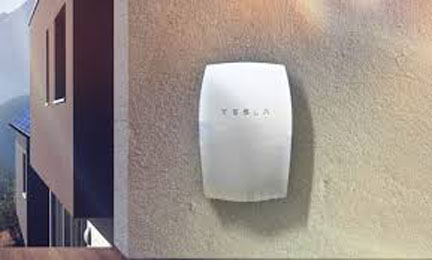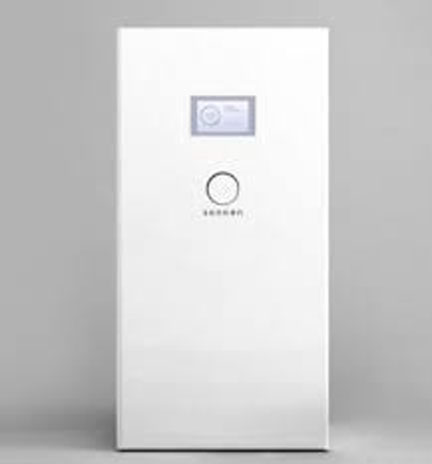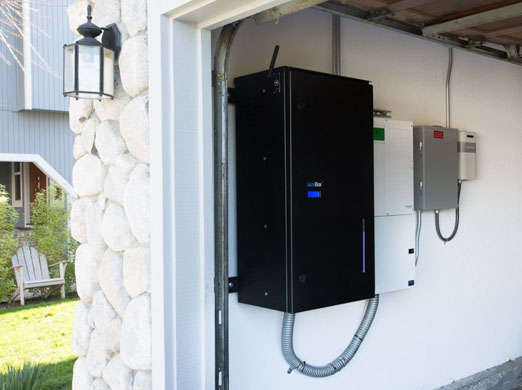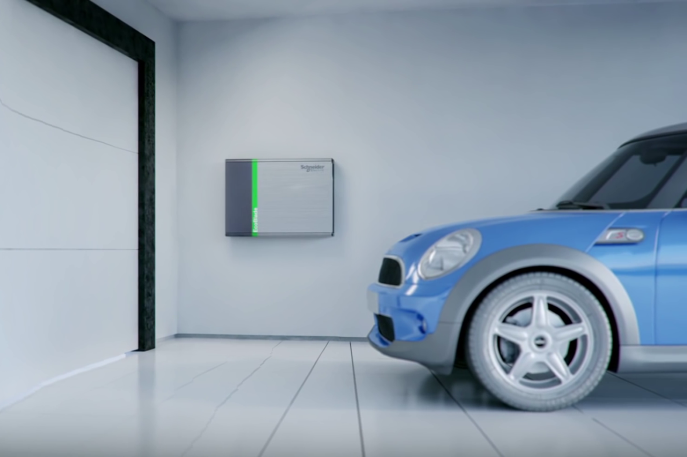The popularity of Tesla’s Powerwall residential battery has pushed the discussion — a long time coming, I think — about the advantages of distributed energy systems for residential and commercial building applications. The battery systems should reduce the peak load that a utility has to provide, although those systems are, of course, a form of competition for that same utility. State and federal regulations and tax breaks will have a lot to do with the near-term growth of this type of system, but the potential for fast-growing sales is definitely there.
The systems provide a battery that charges using solar panels (or from the line when utility rates are low) and powers the home in the evening when rates are higher (if utilities finally institute time-of-day rates). They also fortify a home against power outages.
Tesla says that its automated, compact lithium-ion battery system is simple to install and that Powerwall “offers independence from the utility grid and the security of an emergency backup.” These characteristics are attractive to lots of people, including me. I may finally install solar — something I’ve been thinking about for years.
Are these different from completely off-grid systems? If I can charge my battery all day and use it to run my house all night, do I need the utility? The answer is that without a grid connection, you need a lot of solar panels, and on cloudy, rainy days, it simply won't cut it. Therefore, the grid is probably a must. And the three-way system is optimal.
The packs may have many other uses in military systems, medical equipment, emergency signage systems, elevator emergency operation, and other areas.

Fig. 1: Tesla’s Powerwall .
Tesla recently dropped its 10-kWh model and has only a 6.4-kWh version. This smaller battery seems to fit the bill for many people; if they require more, they can install two units. The 10-kWh version was rated for only 500 cycles. Tesla says the 6.4-kWh unit is for “daily cycle applications” and its warranty is for 10 years, or roughly 5,000 cycles, with a 100% depth of discharge. It features 92.5% round-trip DC efficiency and a power rating of 3.3 kW. The unit operates at 350 to 450 V, has liquid thermal control, and is priced at $3,000.
In January, CEO Elon Musk announced that a new Powerwall version will be released this summer. Version 2 “will see [a] further step-change in capabilities,” he said at the time. That statement has not yet been clarified.
“We delivered over 2,500 Powerwalls and nearly 100 Powerpacks in the quarter throughout North America, Asia, Europe and Africa,” the company said in a shareholder letter. The most popular markets for Powerwall so far have been Hawaii, Australia, South Africa, and Germany.
But now other companies are getting into the game
Sonnen (pronounced zon-nen) has been dubbed “The Tesla Killer” by some people. The German-based company began offering its lithium battery storage system to U.S. customers in December 2015. It has also launched a community network platform, in which a virtual grid powered by solar and storage allows members to trade power among themselves while exporting the excess to the public grid. The CEO calls the platform “the Airbnb of energy.”

Fig. 2: Sonnen offers 4- to 16-kWh units .
With more than 10,000 storage systems in use around the world, Sonnen is in the eighth generation of its residential battery product. In the United States, the company's systems have been installed in 12 states. The systems have a 10-year, 10,000-cycle guarantee and offer 4 to 16 kWh (in 2-kWh steps) units. The dimensions for the smallest one are 26 x 51 x 14 inches. Sonnen uses only lithium-iron phosphate (LiFePO4) batteries. In addition to the battery modules, the all-in-one unit has an inverter, an intelligent energy manager, and measurement technology.
Meanwhile, Adara Power offers an 8.6-kWh storage system for residential use. The company says it has installed systems in seven U.S. states: California, Nevada, New York, Maine, Hawaii, Utah, and North Carolina. The system, composed of lithium-ion batteries, has a controller to monitor the state of the battery, the PV output, and building load from the inverter. The system is guaranteed for 10 years or 4,000 cycles.

Fig. 3: Adara Power’s 8.6-kWh system.
California-based Sunverge was founded in 2009 and recently announced a partnership with New York utility Con Edison to offer storage to more than 300 households as part of a pilot project. Sunverge's Solar Integration System (SIS) can automatically isolate from the grid in the event of a loss of grid power, then deliver power to the site with no interruption in service or loss in power. It has a 10-year warranty.
Schneider Electric ’s EcoBlade is a scalable storage system that hangs on a garage wall, much like the Tesla Powerwall. The EcoBlade includes lithium-ion batteries, a charge controller, an inverter, and energy management software. The 5-kWh EcoBlade is expected to be released sometime in 2016.

Fig. 4: Schneider Electric’s EcoBlade.
Panasonic and Saft also offer this type of product.
Now, micro-inverter company Enphase Energy is getting into the business with its “AC Battery ” product. Two weeks after inviting orders for its new home power storage system, the company registered orders for 60,000 of the units. Enphase has said that Australia and New Zealand are two of its two most promising markets.

Fig. 5: The AC battery from Enphase Energy.
Enphase's tidy 15.4 x 12.8 x 8.7-inch systems use lithium iron phosphate chemistry in cells from Eliiy Power (Japan) and cost $2,000-$2,500 per 1.2-kWh unit. Most installations use two to four units. Enphase touts 96% round-trip efficiency and the ability to handle two cycles/day with a minimum 10-year expected life. The company estimates that a 4.8-kWh installation takes one technician about 1.5 hours.
I think these new grid battery products will make some big waves, and I think it will be soon, as in the next 18 months. However, I must say that I'm often mistaken about the timing of innovation, such as this one. Again, battery cost will make a big difference, and federal and state laws and incentives could make a big difference. Leave us a comment to let us know what you think.
Advertisement
Learn more about APC by Schneider ElectricEnphase EnergyTesla





